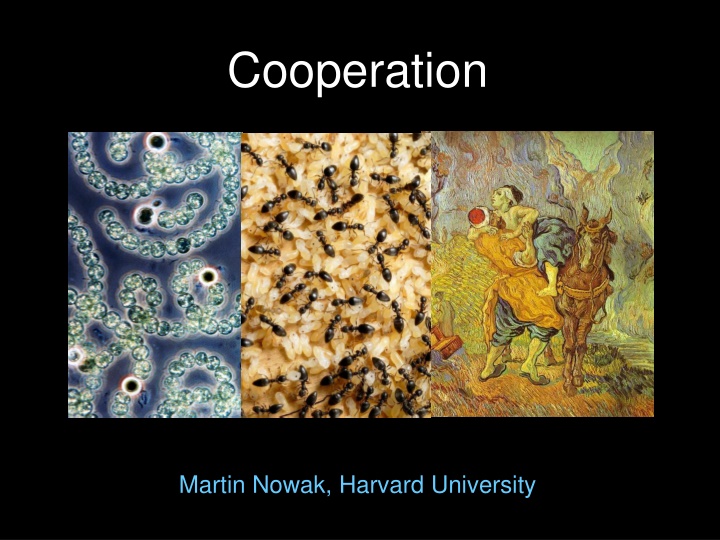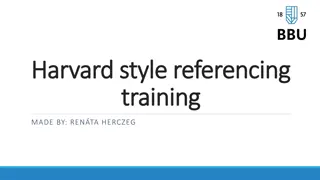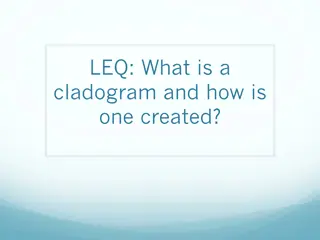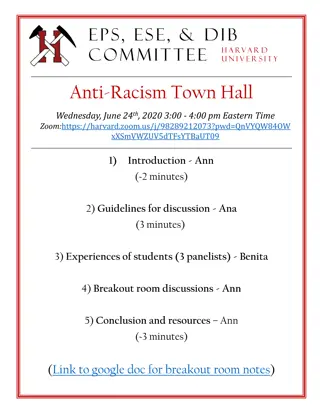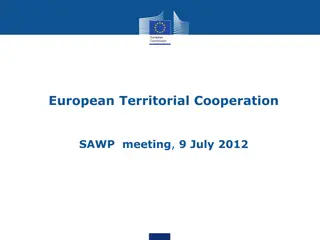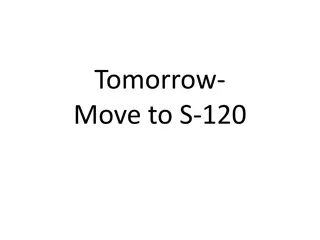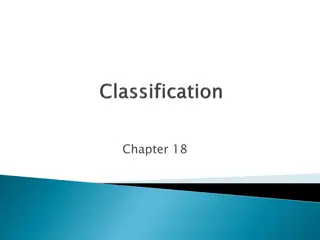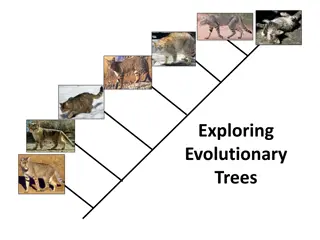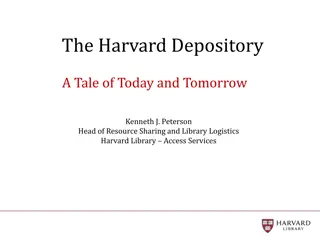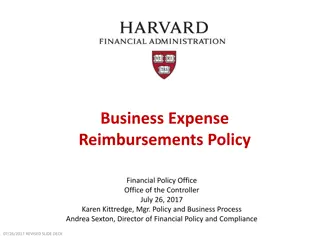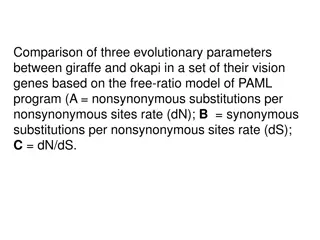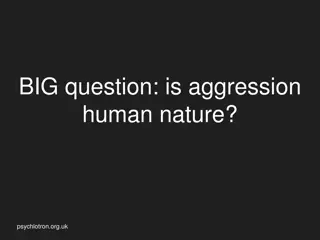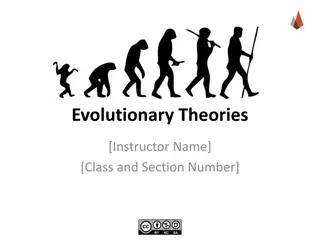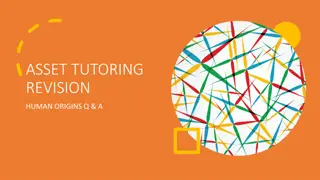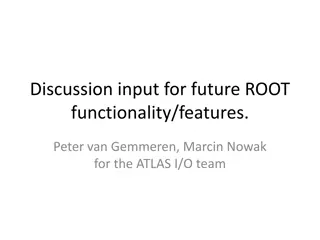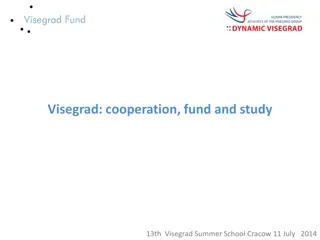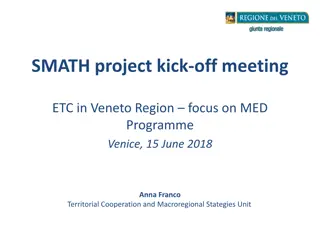Evolutionary Dynamics of Cooperation by Martin Nowak at Harvard University
Explore the evolution of cooperation from the origins of life to human behavior with a focus on mechanisms such as natural selection, direct reciprocity, and the Prisoner's Dilemma. Learn how populations evolve through mutation, selection, and the interplay between cooperation and defection in various scenarios.
Uploaded on Sep 21, 2024 | 2 Views
Download Presentation

Please find below an Image/Link to download the presentation.
The content on the website is provided AS IS for your information and personal use only. It may not be sold, licensed, or shared on other websites without obtaining consent from the author.If you encounter any issues during the download, it is possible that the publisher has removed the file from their server.
You are allowed to download the files provided on this website for personal or commercial use, subject to the condition that they are used lawfully. All files are the property of their respective owners.
The content on the website is provided AS IS for your information and personal use only. It may not be sold, licensed, or shared on other websites without obtaining consent from the author.
E N D
Presentation Transcript
Cooperation Martin Nowak, Harvard University
Time 13.7 Universe 4.6 Sun, Earth, Moon 4.0 Origin of life 3.5 Bacteria 1.8 Eucaria 0.6 Complex multi-cellularity 0.001 Human language Cooperation is the master architect of evolution billion years ago
What is it that evolves? Populations of reproducing individuals
What is cooperation? Donor pays a cost, c Recipient gets a benefit, b
Prisoners Dilemma I cooperate I defect you cooperate b - c - c you defect b 0 you get b > c > 0
What is the dilemma ? Two rational players defect and end up with a low payoff, 0. Two irrational players might cooperate and receive a higher payoff, b c .
Natural selection chooses defection CC C D D C D C C D D D D D D In any mixed population, defectors have a higher payoff than cooperators.
Natural selection needs help to favor cooperators over defectors.
Five mechanisms: Direct reciprocity Indirect reciprocity Spatial selection Group selection Kin selection
Direct reciprocity I help you, you help me.
Repeated Prisoners Dilemma Player 1 : C D C D C C C . Player 2 : D C D D C C C .
Tit-for-tat I start with cooperation. If you cooperate, then I will cooperate. If you defect, then I will defect. Anatol Rapaport
Generous Tit-for-tat I start with cooperation. If you cooperate, then I will cooperate. If you defect, then I will cooperate with a certain probability (q = 1- c / b). Evolution of forgiveness Nowak & Sigmund, 1992
Win-stay, lose-shift If I am doing well (payoff b or b-c) then I will repeat my move. If I am doing badly (payoff 0 or -c) then I will change my move. If b/c<2 then a stochastic variant of WSLS does well (where you return to C after DD only with a certain probability). Nowak & Sigmund, 1993
Tit-for-tat Generous Tit-for-tat Always defect Always cooperate Win-stay, lose-shift
Direct reciprocity allows the evolution of cooperation if w > c / b b benefit c cost w probability of another round
Indirect reciprocity I help you. Somebody helps me.
Indirect reciprocity works via reputation A helps B A does not help B A B A B The reputation of A increases. The reputation of A decreases. donor recipient donor s reputation cooperate -c +b +1 defect 0 0 -1 Nowak & Sigmund, 1998
Experimental confirmation: People help those who help others. Helpful people have a higher payoff in the end. Wedekind & Milinski, 2000
Gossip spreads reputation A helps B A B Reputation of A is updated. Observers gossip Rest of the population
Games of indirect reciprocity are cognitively demanding; individuals need to monitor the social network of a group. => evolution of social intelligence Individuals must be able to talk to each other about others. => evolution of human language
David Haig: For direct reciprocity you need a face. For indirect reciprocity you need a name.
A rule for indirect reciprocity q > c / b q probability to know someone s reputation c cost of cooperation b benefit of cooperation Nowak & Sigmund, 1998
Spatial selection Spatial games Games on graphs Games in phenotype space Games on sets
Spatial games Cooperators Defectors Nowak & May, 1992
Games on graphs D D D C Cooperators Defectors C D C C D C The graph describes a spatial structure or a social network. Lieberman et al, 2005
Spatial selection on graphs favors cooperation if b / c > k k (average) number of neighbors weak selection Ohtsuki et al, 2006
Non-weak selection Ibsen-Jensen et al, 2016
Weak selection any 2x2 game with payoff matrix A B A a b B c d any graph (-t1+t2+t3) a + (t1+t2-t3) b > (t1+t2-t3) c + (-t1+t2+t3) d Allen et al, 2016
Group selection There can be no doubt that a tribe including many members who [...] are always ready to give aid to each other and to sacrifice themselves for the common good, would be victorious over other tribes; and this would be natural selection. Charles Darwin, The Descent of Man, 1871
Group selection Play the game with others in your group. C D DD D Offspring are added to the group. D C C CC CC D C Groups divide when reaching a certain size. Groups die.
Group selection favors cooperators if b / c > 1 + n / m n group size m number of groups Traulsen & Nowak 2006
Kin selection The interaction occurs between genetic relatives. I will jump into the river to save 2 brothers or 8 cousins J.B.S Haldane
What is inclusive fitness? My inclusive fitness is the effect that my action has on my own fitness plus the effect that my action has on any other individual s fitness times the relatedness between me and that other individual, summing over all individuals.
Hamilton (1964) Inclusive fitness may be imagined as the personal fitness which an individual actually expresses in its production of adult offspring as it becomes after it has been first stripped and then augmented in a certain way. It is stripped of all components which can be considered as due to the individual's social environment, leaving the fitness which he would express if not exposed to any of the harms or benefits of that environment. This quantity is then augmented by certain fractions of the quantities of harm and benefit which the individual himself causes to the fitnesses of his neighbors. The fractions in question are simply the coefficients of relationship appropriate to the neighbors whom he affects; unit for clonal individuals, one-half for sibs, one-quarter for half- sibs, one-eighth for cousins,....and finally zero for all neighbors whose relationship can be considered negligibly small.
Inclusive fitness - attempts to calculate fitness of an individual in a social context - relies on pairwise relatedness - assumes additivity of fitness effects
Instead of inclusive fitness, I propose to formulate an evolutionary process and follow evolutionary dynamics over time. Does the genotype (or phenotype) that induces Haldane to jump spread in the population?
In general, there is no inclusive fitness. In most situations, the quantity inclusive fitness does not exist (because fitness effects are not pairwise and not additive). Good news: there is no need for inclusive fitness. There is no phenomenon in evolutionary biology that would require the calculation of inclusive fitness.
Hamiltons rule r > c / b r coefficient of relatedness c cost of cooperation b benefit of cooperation If c and b are the parameters of the payoff matrix, then this rule is almost always wrong.
Hamiltons rule uses other parameters B, C and R. The task is: for any change in the population calculate B , C and R to make Hamilton s rule true. B, C and R all depend on population structure.
Hamiltons rule - makes no prediction - does not aid any calculation - cannot be tested empirically
1. Inclusive fitness is an unnecessary construct. 2. Hamilton s rule makes no prediction. 3. Kin selection is an interesting phenomenon, but needs to be disentangled from inclusive fitness.
Social insects - Evolution of colonies, eusociality - Evolution of non-reproductive workers - Evolution of policing
Five mechanisms for cooperation Direct reciprocity : I help you, you help me. Indirect reciprocity : I help you, somebody helps me. Spatial selection : Neighbors help each other. Group selection : groups of cooperators out-compete other groups. Kin selection : cooperate with genetic relatives using kin recognition.
Direct and indirect reciprocity are the key components for understanding the evolution of any pro-social behavior in humans. But what made us human is indirect reciprocity, because it selected for social intelligence and human language.
We must learn global cooperation . and cooperation with future generations.
Cooperators Ben Adlam (Harvard) Ben Allen (Harvard) Tibor Antal (Edinburgh) Yu-Ting Chen (Harvard) Krishnendu Chatterjee (IST) Feng Fu (Dartmouth) Drew Fudenberg (Harvard) Whan Ghang (Harvard) Christoph Hauert (UBC) Oliver Hauser (Harvard) Christian Hilbe (IST) Moshe Hoffman (Harvard) Lorens Imhof (Bonn) Erez Lieberman (Houston) Robert May (Oxford) Alex McAvoy (Harvard) Hisashi Ohtsuki (Tokyo) Alexander Peysakhovich (Facebook) David Rand (Yale) Johannes Reiter (Harvard) Karl Sigmund (Vienna) Corina Tarnita (Princeton) Arne Traulsen (Ploen) Matthijs van Veelen (Amsterdam) E. O. Wilson (Harvard) Erez Yoeli (Harvard)
